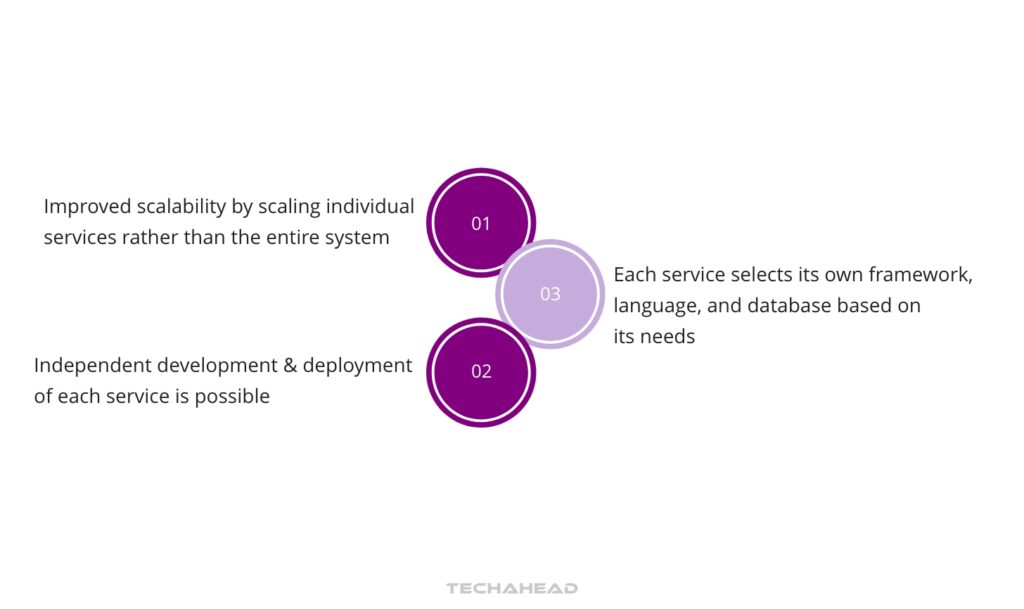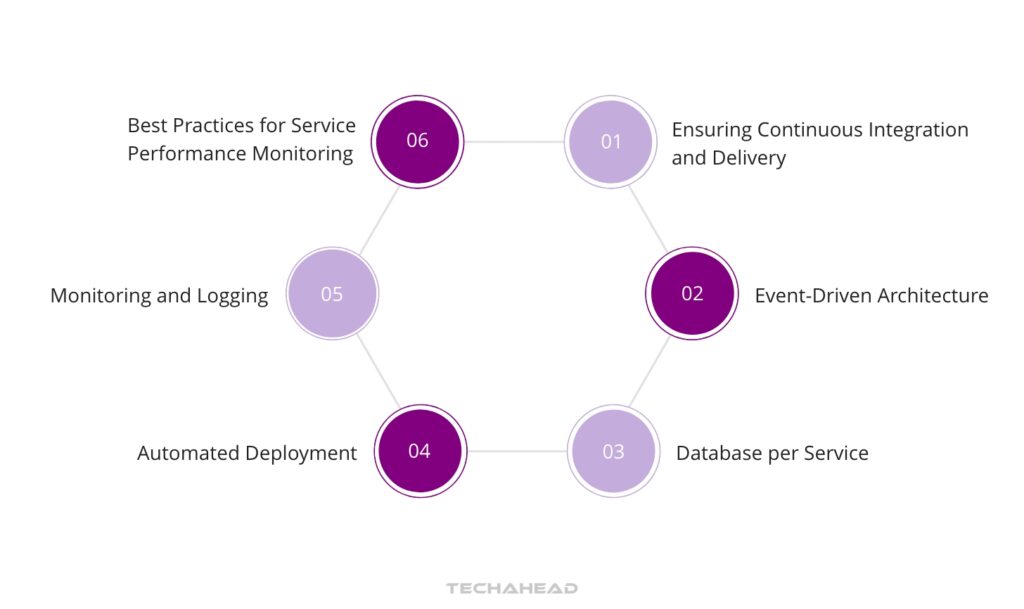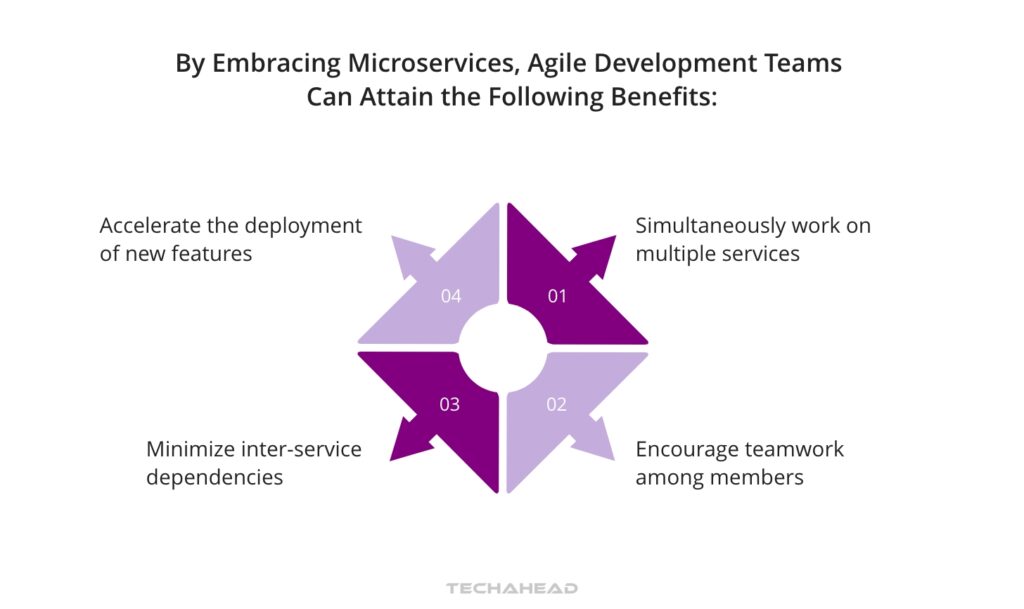
This article will navigate you through the fundamental principles of microservices architecture, a model that is revolutionizing application development by providing scalable, independent, and durable components which collectively create a powerful system. We’ll explore the benefits this method has over conventional monolithic architectures and offer actionable advice on how to tackle the hurdles faced during its deployment.
Key Takeaways
- Microservices architecture divides an application into smaller, independent services that communicate through APIs, improving modularity and flexibility, with each service developed around a single business capability.
- Transitioning from a monolithic architecture to microservices presents challenges, including increased operational complexity and resources needed for maintenance, but offers benefits like increased scalability, independent development, and deployment of services.
- Successful deployment of microservices requires design patterns that cater to isolated service availability, continuous integration and delivery practices, and comprehensive service performance monitoring for effective operation and issue resolution.
Exploring Microservices Architecture

The microservices architecture represents a modern technique that segments a substantial application into smaller, autonomous segments, each dedicated to a particular function. This design principle allows the segmentation of an application’s logic into tiny, encapsulated services that are spread across various computing systems while maintaining loose coupling.
Key features of the microservices architecture consist of:
- Decomposition of services into multiple parts
- High resilience to system failures
- Simplification in message routing
- Decentralization of processes
Consequently, within a microservices framework, every fundamental feature operates autonomously from others and can be updated or deployed without disrupting other interconnected services.
Defining Microservices in Modern Software Development
Microservices fundamentally comprise autonomous services that interact via simple APIs, facilitating a multifaceted array of developmental pathways. This architectural style enables the use of numerous programming languages for development such as Java and Spring Boot, with communication across these services achieved through language-agnostic protocols like REST or messaging systems such as IBM MQ Light.
The sovereignty of microservices also permeates their functionality. Every component within an application based on microservices handles its unique tasks independently, thereby engendering an application architecture that is both more agile and effective.
Core Components of a Microservices Architecture

Within the structure of a microservices architecture, an entire application is constructed as a collection of small, autonomous services. Each service is focused on delivering one specific business function and manages its data domain with well-defined boundaries. As such, applications based on microservices are endowed with enhanced modularity and adaptability.
At the heart of this architectural style is the API Gateway, which is integral for administering various aspects, including:
- Routing user requests
- Crafting responses
- Overseeing authentication
- Implementing throttling
In a microservices setup, individual services within an application interconnect via APIs. This connection framework permits intricate user request handling by aggregating outputs from multiple discrete internal services.
The Role of Containers and Service Mesh
The deployment of microservices often involves containers, which facilitate the development and scaling of services by abstracting dependencies and enabling rapid updates with minimal side effects. Containerization supports the ephemeral nature of microservices, allowing for services to be quickly created, destroyed, and replenished without adverse effects. This characteristic works well with orchestrators like Kubernetes.
Linux container images exemplify transportable microservices, enabling them to be moved from one runtime environment to another with ease, thus bolstering the resilience of the overall application.
Transitioning from Monolithic to Microservices

Transitioning from a monolithic architecture to a microservices architecture provides various benefits, including:
- Enhanced scalability due to the ease of scaling individual services instead of scaling the entire system.
- The freedom for each service to select its distinct framework, programming language, and database tailored to its needs.
- The capability for independent development and deployment of each service.
This architectural shift permits every one of the individual components within the microservices setup to be crafted using optimal technologies specific to their functions while preserving the advantages that come with having loosely coupled services.
Challenges in Adopting Microservices

Transitioning to a microservices architecture, while laden with advantages, also brings about certain challenges. Migrating from a monolithic structure involves an increase in operational complexity as it necessitates the management of numerous individual services.
This requires meticulous planning and evaluation of the organizational capabilities and resources available. There is an amplified demand for efforts to guarantee resilience within applications and oversight over a variety of tools and technology used across these disparate services, resulting in more demanding maintenance tasks.
The specific difficulties associated with evolving into microservices include:
- The requirement to manage multiple distinct services
- The need for comprehensive planning alongside an appraisal of resourcefulness and capacity
- Guaranteeing robustness within the application spectrum
- Overseeing varied tools as well as technological aspects spanned by different services
- Maintenance that demands extensive resources
Notwithstanding these hurdles, often, the strategic gains from adopting microservices surpass such impediments by fostering distributed systems that are both scalable and adaptable.
Although migrating towards this model facilitates increased data storage independence, which enhances service autonomy, it simultaneously can give rise to data handling inconsistencies along with complications concerning data governance attributed to the decentralized setup inherent in both service distribution and processing approaches related to information/data.
Strategic Approaches for Migration
Navigating the transition from a monolithic to a microservices architecture can be complex, but there are certain strategies that can help ease the process. The Strangler Fig pattern offers an incremental approach for refactoring by progressively substituting specific features of the monolithic application with new services.
Domain-driven design is key in organizing microservices according to business domains, which allows teams to focus on distinct sections of the application independently. It’s essential to determine accurate boundaries for each microservice so as not overwhelm them with complexity and maintain their ability to operate autonomously while minimizing interdependencies.
Architectural Styles: Microservices vs. SOA

The microservices architecture and service-oriented architecture (SOA) both implement systems as a collection of smaller, functional services. Where microservices prioritize discrete functions aligned with business goals and support nimble deployment by independent teams, SOA takes on a more comprehensive approach suitable for wide-scale enterprise scenarios.
In terms of inter-service communication within these architectures, microservices typically engage in asynchronous exchanges using platform-neutral protocols such as HTTP/REST to minimize direct dependencies between services. Conversely, SOA is known for its synchronous interaction patterns that can include various messaging standards like SOAP or AMQP. In this ecosystem, an enterprise service bus (ESB) often plays a critical role in orchestrating the interactions amongst diverse services.
Decentralization and Data Management
In microservices architecture, a fundamental distinction from SOA is the data management strategy. This architecture endorses distributed data control, empowering each service to have its own separate and exclusive data storage system that fosters both independent scaling and sovereignty over its own data.
Yet, amidst this decentralization lies a pivotal obstacle: preserving consistency across disparate stores of data within services. This challenge can lead to difficulties such as redundant datasets and complexities when it comes to upholding inter-service data associations.
Design Patterns for Successful Microservices Deployment

For effective implementation of microservices, it is crucial to employ specific design patterns. By tailoring the configuration of each microservice to meet its unique availability needs, we bolster system resilience and isolate failures, preventing them from affecting the broader system.
By adhering to a single concern principle where each microservice concentrates on a distinct function, both maintenance becomes simpler and scalability improves.
Ensuring Continuous Integration and Delivery
The capability to streamline continuous integration and delivery (CI/CD) is a significant advantage of utilizing microservices architectures. They support instant deployments and the adoption of CI/CD methodologies, which leads to regular and seamless software updates.
When transitioning to microservices, it’s essential to incorporate automation within the CI/CD pipeline. This enhances the release mechanism by fully exploiting DevOps practices that emphasize continuous integration and continuous delivery.
Best Practices for Service Performance Monitoring
Ensuring the successful functioning of microservices necessitates vigilant tracking of their performance. Due to the complex nature brought on by myriad components in microservices architectures, identifying problem origins can be challenging. This makes monitoring tools essential for efficiently solving issues.
In order to attain thorough observability of services, it is imperative that microservices are equipped with instrumentation capable of capturing logs, metrics, and traces. This provides critical visibility into how services interconnect and interact.
Real-World Examples of Microservices in Action

Leading technology enterprises such as Amazon, Netflix, and Uber have successfully put the theory of microservices into practice. This approach has improved their systems’ performance and responsiveness while also accelerating development processes and streamlining updates.
The fact that industry powerhouses like Spotify and Uber are embracing microservices highlights the transformative potential this architectural style holds for scalability, agility, and innovation in major tech organizations.
Streamlining Business Processes with Microservices
The implementation of a microservices architecture not only enhances the efficiency of software development workflows, but also optimizes business functionalities. By facilitating the recycling of functions for different features within an application, this approach boosts developer output and accelerates the introduction of new features to the market.
Embracing microservices within cloud environments promotes swift and effective processes in terms of development, deployment, and updates to services. This adaptability is vital for maintaining competitive advantage in dynamic market conditions and supports continuous innovation.
Microservices and Cloud Native Applications
Cloud-native applications thrive alongside microservices, as they naturally align with the on-demand scalability and advantages offered by serverless deployment models within such environments.
With services like Lambda, AWS bolsters the capabilities of microservices by enabling code to run without managing servers. This promotes autonomous scaling and ensures that components of the service remain highly available.
Embracing Scalability and Resilience
The ability to scale and maintain robustness efficiently are significant advantages offered by microservices within cloud settings. These architectures facilitate accurate scaling of the infrastructure as well as precise cost assessments, due to the capability for each service to be scaled individually in accordance with its unique demands.
A development team has the flexibility to independently adjust the size of microservice components during runtime. This independence ensures that resources are utilized effectively and permits swift adjustments in response to fluctuations in workload.
Leveraging Microservices for Cross-Functional Teams

Microservices offer considerable advantages to both an organization’s technology stack and its development teams. By adopting microservices, agile development teams can achieve the following:
- Simultaneously work on multiple services
- Encourage teamwork among members
- Minimize inter-service dependencies
- Accelerate the deployment of new features
Such an architectural style improves collaboration across cross-functional teams by implementing practices similar to Spotify’s guilds that promote collective knowledge, while also granting teams defined ownership and clear objectives, thereby fostering superior management and creativity within projects.
Summary
Microservices architecture is reshaping the way organizations develop and manage software. By allowing a large application to be divided into smaller, independent parts, microservices offer increased scalability, flexibility, and resilience. While the transition from monolithic to microservices can be complex, strategic approaches and design patterns can ease the migration. Real-world examples from industry leaders like Amazon, Netflix, and Uber underscore the transformative potential of microservices for both software development and business operations. As we move into an increasingly digital future, embracing the agility and adaptability of microservices will be key to staying competitive and innovative.
Frequently Asked Questions
What are the 3 C’s of microservices?
In the design of microservices architecture, it is crucial to adhere to three fundamental principles known as the 3 C’s: componentize, collaborate and connect. These core concepts are essential for crafting effective microservices systems.
What is an example of a microservice?
Companies such as Amazon, Netflix, Uber, and Etsy have effectively utilized microservice architecture to improve their systems. These entities serve as prime examples of microservices in action.
What is meant by microservices?
In the domain of software development, microservices represent a design strategy wherein various small, autonomous services interact through precisely defined APIs. This method enhances scalability and facilitates easier upkeep while ensuring that other services remain unaffected.
What are the key characteristics of a microservices architecture?
A microservices architecture is distinguished by its division of a substantial application into smaller, autonomous components, each with a distinct responsibility and the capability to operate and be deployed independently. It features multiple elements, exhibits resilience in the face of failures, employs straightforward routing methods, and embraces decentralization in its operations.
What are the challenges in adopting microservices?
Adopting microservices can lead to a rise in operational complexity, necessitate additional efforts for guaranteeing application durability and involve handling a wide array of tools and technologies.
Due to the dispersed nature of services within this architecture, there is potential for irregularities to occur in the management of data.



